How python operates mysql
How to operate mysql in python: first enter the command line pip install pymysql to import the package; then open the pycham editor to create a python file, enter import pymysql to import the package; finally operate the database through the cursor.
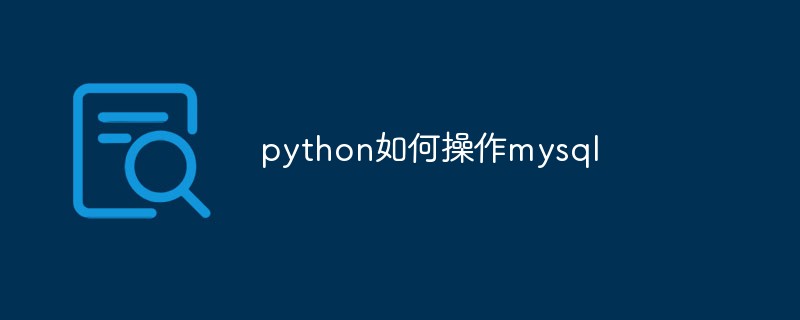
The operating environment of this tutorial: windows7 system, mysql8.0.22&&python3.9 version, DELL G3 computer. This method is suitable for all brands of computers.
Related free learning recommendations: mysql video tutorial, python video tutorial
How to operate mysql in python:
1. First, enter the command line pip install pymysql on the virtual machine or the local cmd command line to import the package. The initial package import takes a long time, just wait patiently for the data to be loaded.
Note: If your python is running locally, import the package in cmd. If you are running in a virtual machine, you can import the package in Xshell.
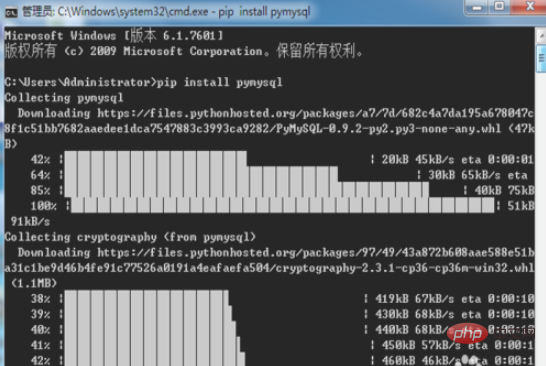
2. Open the pycham editor to create a python file, then enter import pymysql to import the package, and then establish a connection data inventory and python connection.
con =pymysql.connect(
host = '127.0.0.1',
port =3306,
user = 'mango',
password = '123456',
db = 'test1',
charset = 'utf8'
)Note: host is the local IP address, port is the port number, user is the database username, and password is the database password. db refers to the data name of the operation, and charset is the encoding format.
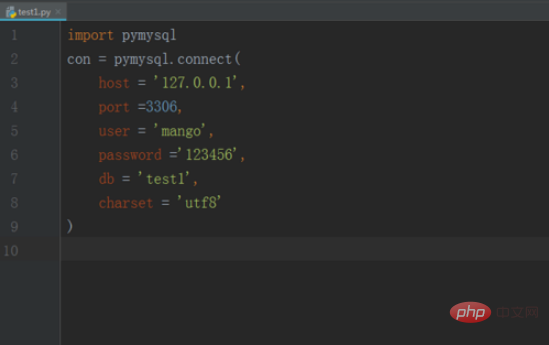
3. After setting up the connection between Python and the database, define a cursor and operate the database through the cursor. The definition method is as follows: cur = con.cursor( )
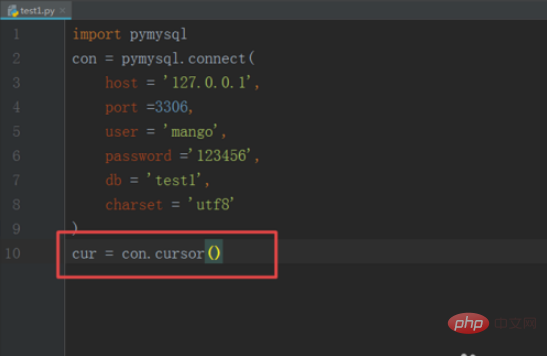
4. Use cur.execute() to execute sql statements, such as querying all tables in the data inventory. The specific operations are as follows:
row = cur.execute('show tables') print(row)
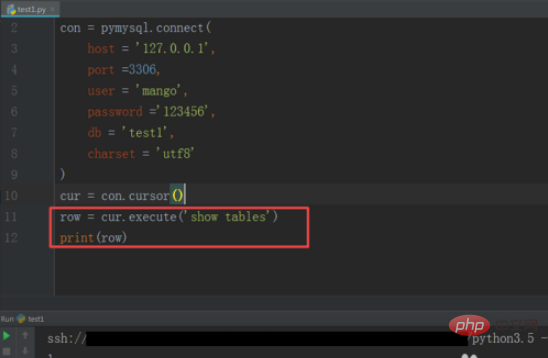
5. Through the above operation, we can see how many tables there are in the database, so how to get out the data in the table.
At this time, cur.fetchall() will be used to fetch data. The specific operations are as follows:
all = cur.fetchall() print(all)
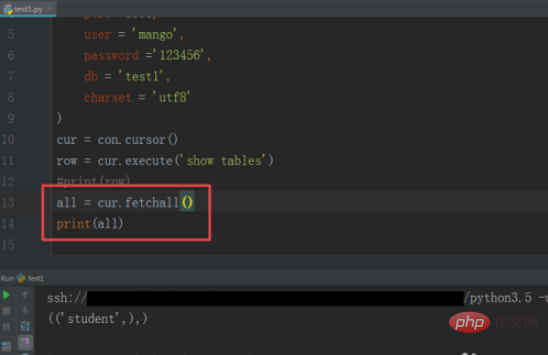
6. After learning to simply execute sql statements and get data, we can start to create tables in the database through python. Create a variable to receive the sql statement. Use triple quotes to facilitate free line breaks when editing the sql statement. The specific operations are as follows:
table = ''' create table test0( id INT, name CHAR(10) )''' cur.execute(table)
Note: After creating the table, you need to comment out cur.execute(table) to avoid repeated execution of sql statements, resulting in error reminders.

7. After creating the table, we can insert data into the table. At this time, we need to use conn.commit() to commit the transaction, otherwise the data will not be written. to the database. The specific operations are as follows:
cur.execute(”insert test0 value(1,‘小王’)”) con.commit()
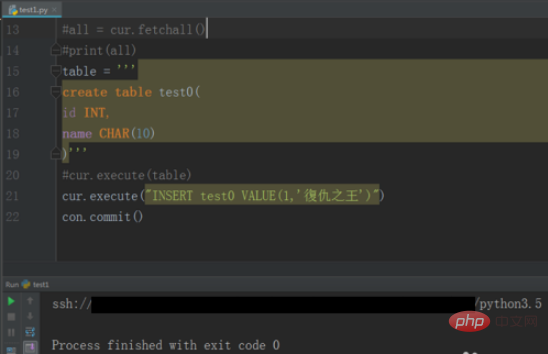
8. Through the above operations, we have learned how to insert a piece of data into the database. So what if we want to insert multiple pieces of data into the database? At this time You need to use cur.executemany(). The specific operation is as follows:
cur.executemany(“INSERT test0 VALUE(%s,%s)”,[(2,‘小白’),(3,’小五’)]) con.commit()
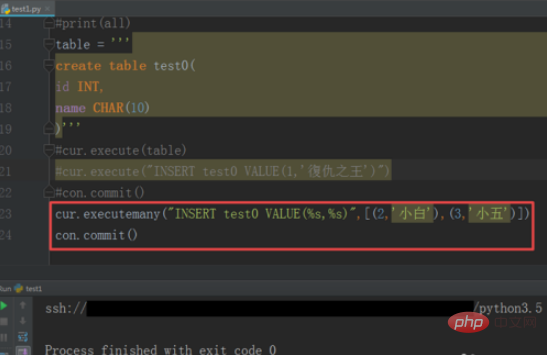
9. Then we can view it through the previous aspect of fetching data. The data in the test0 table, the specific operations are as follows:
select = cur.execute('SELECT * FROM test0') all = cur.fetchall() print(all)
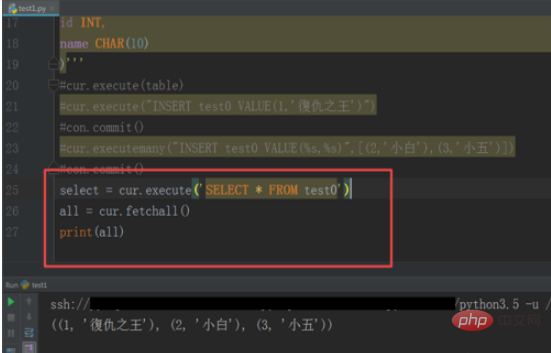
10. Finally, when we finish and continue programming, we need to close the cursor and disconnect.
cur.close()关闭游标 con.close()关闭连接
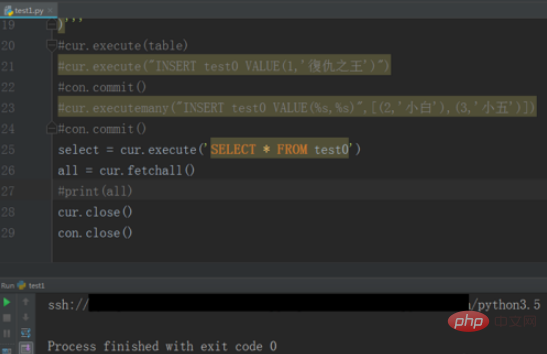
The above is the detailed content of How python operates mysql. For more information, please follow other related articles on the PHP Chinese website!

Hot AI Tools

Undresser.AI Undress
AI-powered app for creating realistic nude photos

AI Clothes Remover
Online AI tool for removing clothes from photos.

Undress AI Tool
Undress images for free

Clothoff.io
AI clothes remover

Video Face Swap
Swap faces in any video effortlessly with our completely free AI face swap tool!

Hot Article

Hot Tools

Notepad++7.3.1
Easy-to-use and free code editor

SublimeText3 Chinese version
Chinese version, very easy to use

Zend Studio 13.0.1
Powerful PHP integrated development environment

Dreamweaver CS6
Visual web development tools

SublimeText3 Mac version
God-level code editing software (SublimeText3)

Hot Topics
 1664
1664
 14
14
 1422
1422
 52
52
 1316
1316
 25
25
 1267
1267
 29
29
 1239
1239
 24
24
 MySQL and phpMyAdmin: Core Features and Functions
Apr 22, 2025 am 12:12 AM
MySQL and phpMyAdmin: Core Features and Functions
Apr 22, 2025 am 12:12 AM
MySQL and phpMyAdmin are powerful database management tools. 1) MySQL is used to create databases and tables, and to execute DML and SQL queries. 2) phpMyAdmin provides an intuitive interface for database management, table structure management, data operations and user permission management.
 Explain the purpose of foreign keys in MySQL.
Apr 25, 2025 am 12:17 AM
Explain the purpose of foreign keys in MySQL.
Apr 25, 2025 am 12:17 AM
In MySQL, the function of foreign keys is to establish the relationship between tables and ensure the consistency and integrity of the data. Foreign keys maintain the effectiveness of data through reference integrity checks and cascading operations. Pay attention to performance optimization and avoid common errors when using them.
 Python vs. C : Understanding the Key Differences
Apr 21, 2025 am 12:18 AM
Python vs. C : Understanding the Key Differences
Apr 21, 2025 am 12:18 AM
Python and C each have their own advantages, and the choice should be based on project requirements. 1) Python is suitable for rapid development and data processing due to its concise syntax and dynamic typing. 2)C is suitable for high performance and system programming due to its static typing and manual memory management.
 Laravel vs. Python (with Frameworks): A Comparative Analysis
Apr 21, 2025 am 12:15 AM
Laravel vs. Python (with Frameworks): A Comparative Analysis
Apr 21, 2025 am 12:15 AM
Laravel is suitable for projects that teams are familiar with PHP and require rich features, while Python frameworks depend on project requirements. 1.Laravel provides elegant syntax and rich features, suitable for projects that require rapid development and flexibility. 2. Django is suitable for complex applications because of its "battery inclusion" concept. 3.Flask is suitable for fast prototypes and small projects, providing great flexibility.
 Python vs. C : Which Language to Choose for Your Project?
Apr 21, 2025 am 12:17 AM
Python vs. C : Which Language to Choose for Your Project?
Apr 21, 2025 am 12:17 AM
Choosing Python or C depends on project requirements: 1) If you need rapid development, data processing and prototype design, choose Python; 2) If you need high performance, low latency and close hardware control, choose C.
 Does Python projects need to be layered?
Apr 19, 2025 pm 10:06 PM
Does Python projects need to be layered?
Apr 19, 2025 pm 10:06 PM
Discussion on Hierarchical Structure in Python Projects In the process of learning Python, many beginners will come into contact with some open source projects, especially projects using the Django framework...
 Compare and contrast MySQL and MariaDB.
Apr 26, 2025 am 12:08 AM
Compare and contrast MySQL and MariaDB.
Apr 26, 2025 am 12:08 AM
The main difference between MySQL and MariaDB is performance, functionality and license: 1. MySQL is developed by Oracle, and MariaDB is its fork. 2. MariaDB may perform better in high load environments. 3.MariaDB provides more storage engines and functions. 4.MySQL adopts a dual license, and MariaDB is completely open source. The existing infrastructure, performance requirements, functional requirements and license costs should be taken into account when choosing.
 Golang vs. Python: The Pros and Cons
Apr 21, 2025 am 12:17 AM
Golang vs. Python: The Pros and Cons
Apr 21, 2025 am 12:17 AM
Golangisidealforbuildingscalablesystemsduetoitsefficiencyandconcurrency,whilePythonexcelsinquickscriptinganddataanalysisduetoitssimplicityandvastecosystem.Golang'sdesignencouragesclean,readablecodeanditsgoroutinesenableefficientconcurrentoperations,t




